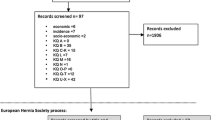Abstract
Background
During laparoscopic ventral/incisional hernia repair (LVIHR), conversion to conventional (open) technique is required when safe adhesiolysis is not possible, incarcerated bowel in hernial sac cannot be reduced or for repair of iatrogenic enterotomies. A formal laparotomy in these circumstances entails significant morbidity due to factors such as wound infection, prolonged immobility, and longer hospital stay.
Materials and methods
During a period between 1994 and 2007, 1,503 LVIHRs were performed at our centre following a standardized protocol by five consultants and fellows. Out of these, 6 patients had a formal laparotomy in the initial part of our experience and 26 patients had a limited conversion to facilitate completion of LVIHR. We have devised the term “limited conversion” for the procedure wherein bowel reduction/adhesiolysis/enterotomy repair was performed through a small targeted skin incision. This was followed by laparoscopic placement of intraperitoneal mesh.
Results
Conversion to an open procedure was required in 32 (2.1%) out of 1,503 LVIHR procedures. Twenty-six patients underwent a limited conversion and completion of the repair by laparoscopy. All but one of these patients had intraperitoneal placement of mesh by laparoscopic route. The wound complication rate was 3.8% (one patient), the mean hospital stay was 2.1 days, and mean operative time was 124 min.
Conclusion
Limited conversion offers a safe alternative to a formal laparotomy in patients with bowel incarcerated in hernial sacs or in patients requiring extensive bowel adhesiolysis. Patient morbidity is reduced due to the targeted skin incision whilst retaining several advantages of a minimal access approach viz. laparoscopic evaluation of the entire abdominal wall and placement of a large intraperitoneal prosthesis.





Similar content being viewed by others
References
Eitan A, Bickel A (2002) Laparoscopically assisted approach for postoperative ventral hernia repair. J Lap Adv Surg Tech 12(5):309–311
Salameh JR, Sweeney JF, Graviss EA, Essien FA, Williams MD, Awad S, Itani KM, Fisher WE (2002) Laparoscopic ventral hernia during the learning curve. Hernia 6(4):182–187
Barbaros U, Asoglu O, Seven R, Erbil Y, Dinccag A, Deveci U, Ozarmagan S, Mercan S (2007) The comparison of laparoscopic and open ventral hernia repairs: a prospective randomized study. Hernia 11(1):51–56
Neff M, Cantor B, Geis WP (2005) Laparoscopic-assisted primary repair of a complicated ventral incisional hernia. JSLS 9:241–244
Ng JW (2004) A case of small Spigelian hernias successfully treated by a simple laparoscopy-assisted technique. Surg Laparosc Endosc Percutan Tech 14(5):300–333
Author information
Authors and Affiliations
Corresponding author
Rights and permissions
About this article
Cite this article
Sharma, A., Mehrotra, M., Khullar, R. et al. Limited-conversion technique: a safe and viable alternative to conversion in laparoscopic ventral/incisional hernia repair. Hernia 12, 367–371 (2008). https://doi.org/10.1007/s10029-008-0363-3
Received:
Accepted:
Published:
Issue Date:
DOI: https://doi.org/10.1007/s10029-008-0363-3




